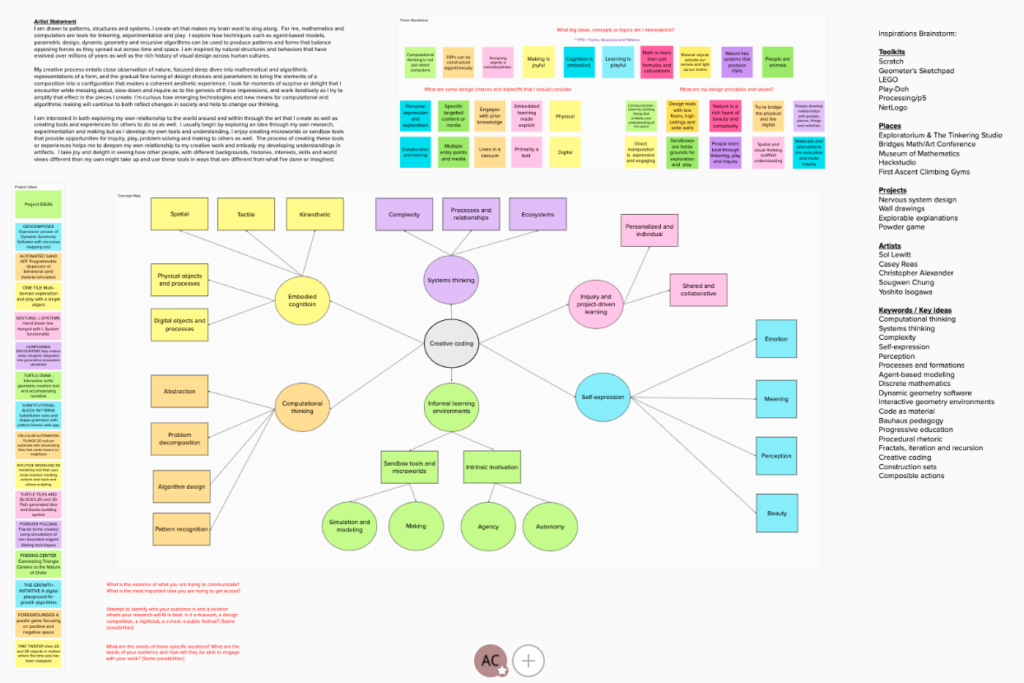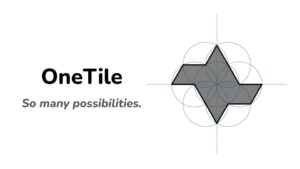Week 1 – Mind map and project brainstorm

This week I began by thinking about my own identity as a designer and artist and my passions and interests with the goal of brainstorming a list of potential thesis projects.
The full mural board described in this post can be viewed here:
Here is a brief summary of the major components of the map and my major takeaways.
Artist statement
I had written an earlier draft of an artist statement for class that I had taken through the School of the Art Institute of Chicago’s Continuing Studies program last Spring. I slightly revised the statement to also reflect a growing awareness of my commitment to progressive and contructionist learning theories, my interest in both developing my own projects and making tools available to others for exploration, and a desire to put those tools in the hands of a diverse range of people that will use them in ways that go beyond what I might have thought to do.
Overall, I’m pretty pleased with the statement and feel like it captures something essential about me.
Three questions
Before diving into thinking about specific projects, I decided to try to articulate some key ideas related to three more general questions. Drawing on prior projects, my teaching experiences, and people, places or projects that have impacted my thinking, I brainstormed answers to the following three questions:
- What big ideas, concepts or topics am I interested in?
- What are my design principles and values?
- What are some design choices and tradeoffs that I should consider?
Concept map
Next, I tried to integrate some of the ideas that kept coming up for me and the emerging picture of ‘the kind of project’ that I imagine wanting to work on into a general concept map. After some consideration, I made Creative Coding the central node for this network. I think that makes sense as I find that underlying most projects that I consider working on is the beauty and value of computation and coding for helping us to make sense of the world and express ourselves creatively. The map is pretty general, but some more specific examples of my particular interests have made their way in such as learning in informal contexts, spatial thinking and evolved complex systems.
Project ideas brainstorm
Now that I had oriented myself and begun to get a sense for general parameters to think about in brainstorming ideas, I dove right in and tried to brainstorm a list of possible project ideas. The ideas that came out ranged from ones I had already started to ones I knew I was interested in to a few completely novel ideas that coalesced through this process.
Sharing a prototype at Feedback Collective

I also had a chance to share a very simple prototype of the OneTile project with the IMA Low-Res Feedback Collective. My classmates were very helpful in providing some usability feedback as well as a few ideas for possible directions to consider.
Sharing inspirational projects and prior work
For our Thesis Development Studio, we were asked to get together with a few other folks in the class and share three projects that we find inspirational and three examples of previous projects we had worked on. I opted to share three projects that I had been working on prior this year to remind myself a bit of the things I was choosing to do with no constraints attached. I also shared two artists work that I was already familiar with and was delighted to have a new artist show up in my YouTube feed that morning that I could also include. This video about Andres Amador’s Earthworks projects was an exciting new find for me:
Overall, this sharing out reinforced for me that my mind map and project idea brainstorm were aligning nicely with work I’ve done and to which I’m drawn.
Moving forward, I hope to identify 3 possible projects from my brainstorm, flesh them out a little bit more and, if possible, start to develop simple prototypes of each.
Related Posts
Leave a Reply Cancel reply
You must be logged in to post a comment.
Kat Sullivan
Adam Colestock
Helen (Chenuan) Wu
Christina Lan
Dorian Janezic
George Faya
Julia Myers
Kelsie Smith
Michael Morran
Po-Wen Shih
Liu Siyan
Fisher Yu
—
Craig Protzel
Christopher Wray
Haoqi Xia
Hayden Carey
Katherine Nicoleta Helén
Maria Maciak
Parisa Shemshaki
Sakar Pudasaini
Skyler Pierce
Steven Doughty
Yiqi Wang
—
Andrew Lazarow
Benoit Belsot
Enrique García Alcalá
Hongyi Zhang
Jay Mollica
Li Shu
Teddy (Jian) Guo
Monika Lin
Wenye Xie
Yiru Lu
